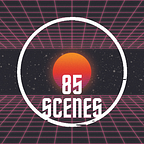I’ve seen Tom Cruise’s Oblivion maybe half a dozen times, and I can tell you with confidence, this movie deserves a place among the pantheon with the best sci-fi films of all time. The score is stellar, the visuals are unparalleled, and the story is original and gripping. I cite Joseph Kosinski’s 2013 film as a major inspiration to my own visual, storytelling and artistic endeavors. If you haven’t seen the movie, I recommend you do.
Scavenging a Climax
Let’s start with the stuff that isn’t that great, because the list of that stuff is very short. Reportedly, the film began as a comic, which would explain why the film feels almost episodic, with smaller arches of tension building up to the larger climax. This larger climax, however, lacks the gutpunch and gusto of a traditional sci fi crescendo, what with its larger than life space battles and lasers and such. Instead, the film ends with an emotional, philosophical sacrifice and compromise, one that feels unearned and sort of forced.
The protagonist, Jack Harper, is revealed to simply be a clone, and there are reportedly thousands more of him scattered about the planet. These clones are not the true Jack Harper, the one who Olga Kurylenko’s character, Julia, is married to. Nonetheless, we’re asked to care for her love for this copy, and accept that she feels hurt by his loss. Furthermore, there’s this weird little moment where it turns out they had a child together that happens after the end of the film. But wait, there’s more! Another Jack Harper clone shows up and, according to the narration, intends to take the place of the vacant late father/husband. It’s so weird, and presents a set of emotional complications that are left unresolved. In fact, even after my sixth rewatch, I’m not on board with the end telling us that a new Harper can easily and readily replace Julia’s husband for the third time.
Branching backwards from that, the human survivors and their entire section of the narrative is the weakest, least compelling part of the film. Yes, they’re human survivors, and the aliens defeated us and we should root for the grimy little kids hiding underground from the robots, but fuck if I care. They’re just copy/paste of the survivors from the Matrix trilogy (soon to be quadrilogy), or any number of post apocalyptic survivors from other works. I don’t care about some future New Yorkers, I hardly care about current New Yorkers.
Bringing things full circle, it’s easy to see that a lot of emotional development was left on the drawing room floor when the film was adapted from being a comic book, and this is just the nature of things. It’s like asking us to adapt a song from a painting, or a sculpture from a poem. It’s possible, but difficult. Unfortunately, the stuff that was left behind was necessary for the end to incite any sort of emotion, and thus ends my gripes with the film.
Sci-Fi Artistry
Here’s the good stuff. This movie rocks. The soundtrack, developed by M83 and Joseph Trapanese, is gripping and extraordinary. It’s exciting, futuristic, cinematic, intriguing, delicate and energetic all at once. It balances the film’s action and themes of humanity perfectly, and I don’t know what came first, the movie or the soundtrack (the movie came first). Trapanese also collaborated with director Kosinski and little known indie band Daft Punk on Tron: Legacy, which was a similarly visually excellent, and audially stellar soundtrack. Coincidentally, Trapanese has gone on to work on Finding O’hana, an adventure movie I watched sitting at a 45 degree angle over the summer.
The visuals and CGI in this movie are absolutely gorgeous, even eight years on. I can’t find any flaws in the rendering, the physics, the colors, any of it. Even at this age, the film puts modern blockbusters like Avengers to shame. Kosinki opted to use a combination of both practical effects and visual effects to deliver an accurate and detailed world. This results in a film that is gorgeous, inspired and doesn’t distract. The effects do their job of crafting an environment close to ours, but different enough to incite intrigue. It’s the post-apocalypse, after all. Things are supposed to be different, but not so different that it’s Star Wars.
Post apocalyptic world building
That leads to the world building aspect of this film. For a post apocalyptic, action adventure sci-fi movie, Oblivion does an incredible job of constructing this world for us, aided by a soft mix of flashbacks and narration. It’s nearly unavoidable for a film like this one, and save for a more developed, inspired script, there’s not much you could have done to do a better job of things. Of course, Dennis Villeneuve’s upcoming Dune may show us how to develop a sci-fi otherworldly backstory for us without exposition or cheap techniques, but that guy is a genius and a visionary.
Don’t get me wrong, Kosinki is inspired and innovative, and I don’t mean to knock his creativity, because this movie is absolutely up there with films like Annihilation, Arrival, Interstellar, and Gravity. It’s not exactly Ex Machina, but it isn’t fucking Jupiter Ascending either.
Yes, this movie leaves a little something lacking in terms of development and explanations, leaving a lot of gaps for us to fill emotionally. Nonetheless, there are notes of Joseph Kosinki’s literary vision in the script, especially shining in some of the visuals, creative decisions and what is essentially poetry in the script. I rate Oblivion a 7/10. The score reflects dings for the undeserved emotional moments, absence of character development, and a climax that ended up getting a little too weird.
Feed my ego by following my Twitter, Instagram or Youtube.
Originally published at http://85scenesreviews.wordpress.com on November 16, 2021.
